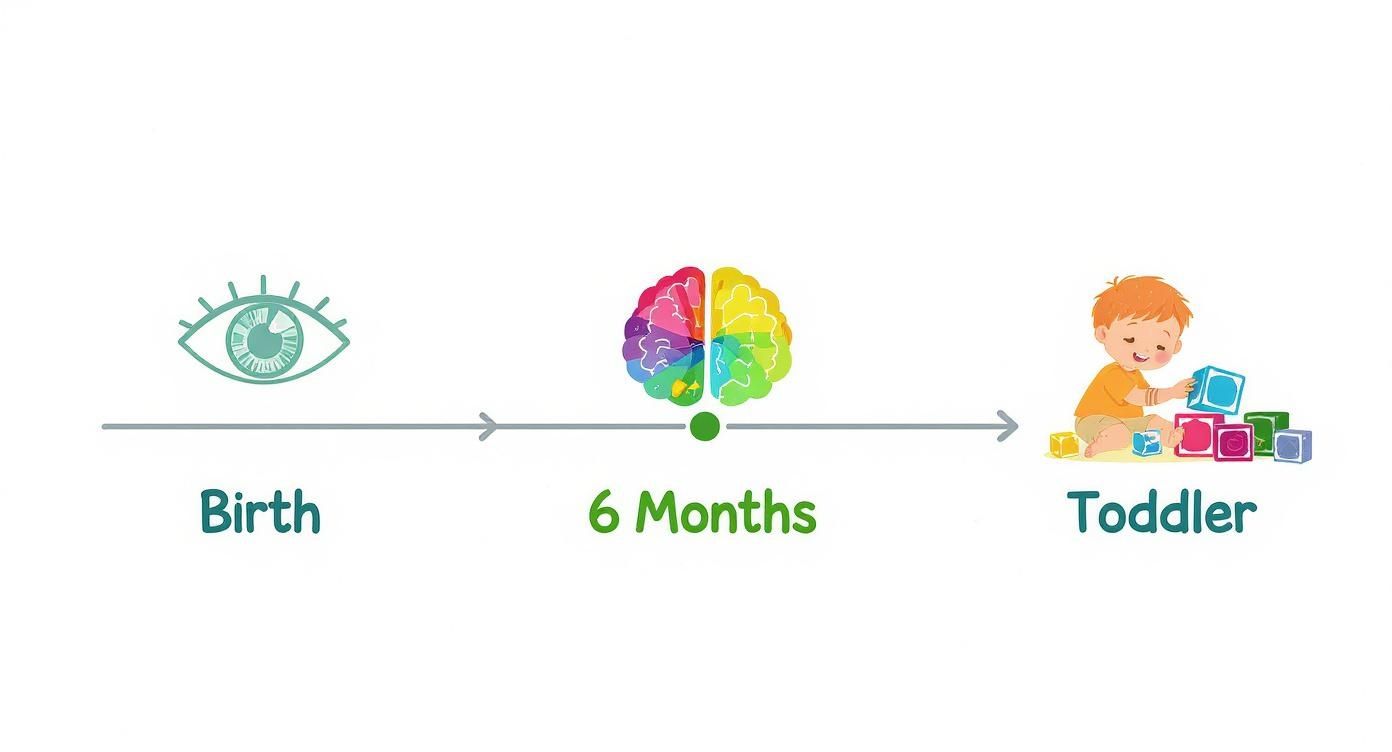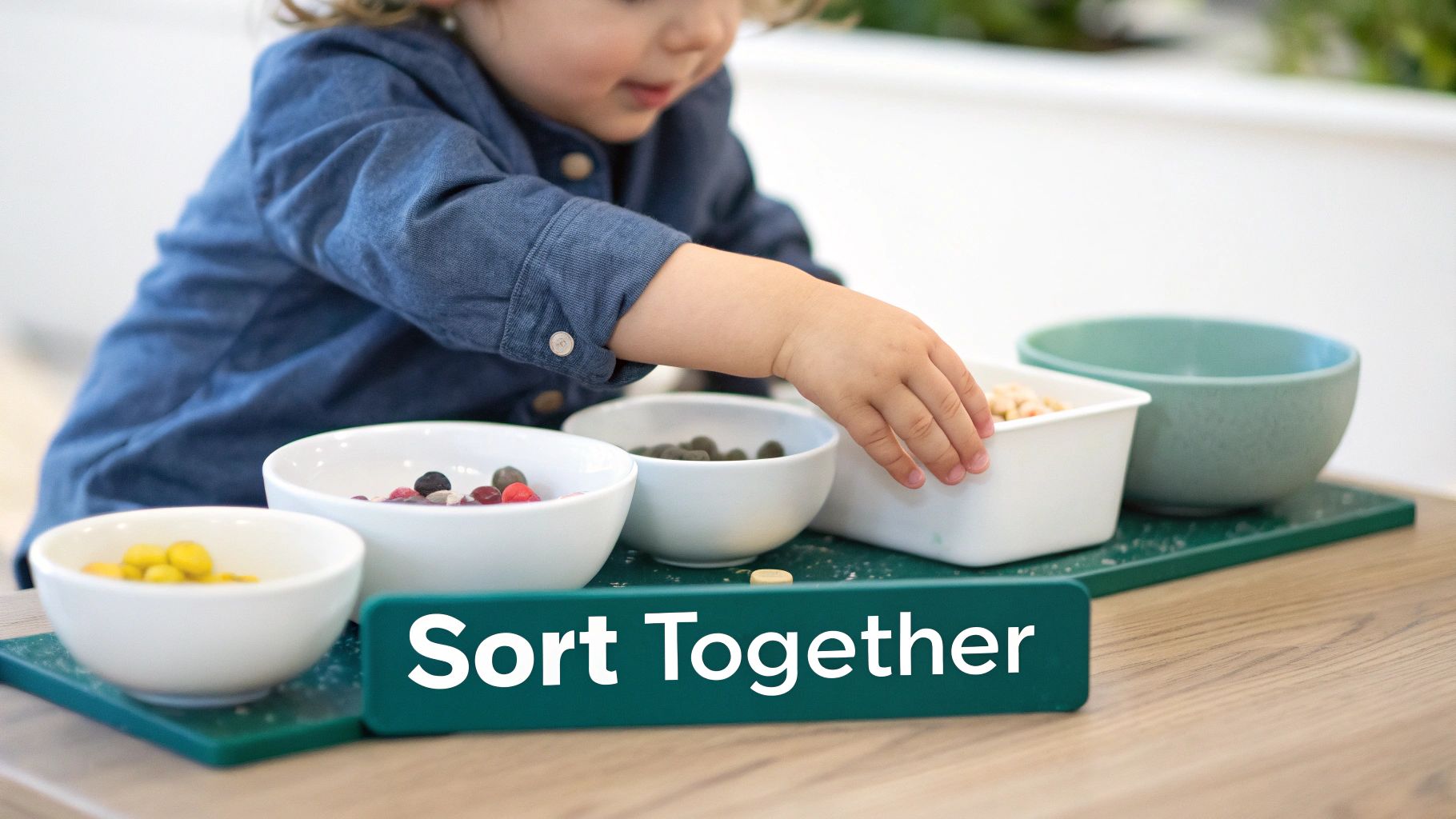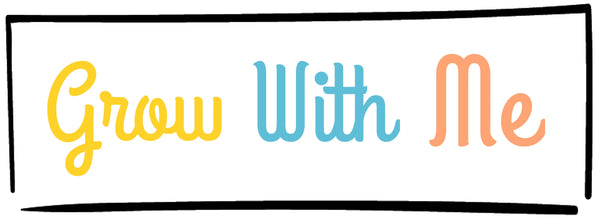
Learning colours for toddlers: Fun ways to explore colours
Share
Teaching your toddler their colours isn't about formal lessons or flashcards. It's really a journey of discovery that happens best through everyday play. The secret is to weave colour recognition into the fun, real-world things you're already doing together.
This helps them see how colours describe and categorise the world around them. When you take this playful approach, learning becomes a natural and joyful milestone, not a chore.
Why Play is the Best Way to Learn Colours
A toddler's brain is wired to learn through experience and interaction. When learning about colours is part of a game or a cuddle with a favourite book, the information just sticks. It connects an abstract word like "blue" to something real and tangible, like their beloved soft toy.
This simple method transforms learning from a task into a special moment of connection.
It's not just a gut feeling, either. The science absolutely backs up a play-based approach. Young children are natural explorers, and their ability to perceive and categorise things is surprisingly sharp, even from a very early age.
Research in the UK has shown that by just six months, infants can already perceive and group different colours. This early ability is a foundational building block for cognitive development, helping them make sense of their environment. You can read the full research about toddler colour perception to learn more.
This innate skill is exactly why integrating colour into sensory activities is so powerful.
Make Learning an Adventure
Instead of setting aside specific "colour time," just make it a seamless part of your day. It’s easier than you think.
Here are a few simple ways to get started:
- Talk about what you see: Point out the green grass at the park or the red apple you're slicing for a snack. It’s about narrating your world in a colourful way.
- Get hands-on with sensory fun: Simple activities like squishing coloured play-doh or splashing in tinted water build incredibly strong neural connections. For more great ideas, check out our guide on sensory play ideas for toddlers.
Building a Colour Vocabulary Through Conversation
Before your toddler can tell a red block from a blue one, they first need the words. The best way to introduce these words isn't through flashcards or formal lessons, but by weaving them into your daily chats. This turns ordinary moments into fun little learning opportunities.
Start simple. I always found it best to focus on just a few primary colours at a time—think red, yellow, and blue. When you're getting them dressed, you can say something like, "Let’s put on your blue socks today." This low-pressure approach makes learning about colours a natural part of conversation, not a quiz they have to pass.
Make Everyday Objects Your Teaching Tools
Your house is already a treasure trove of colourful teaching aids. You don't need to buy anything special; just use what’s around you.
At snack time, try asking, "Would you like the yellow banana or the red apple?" When you're out for a walk, point out a big green bus or the neighbour's purple flowers. You can even talk about the different shades on their clothes, like on a 'Color Block Sweatshirt Shorts Set'. The real magic happens through repetition in different, meaningful contexts.
It’s completely normal for children to learn colours at different speeds. To give you a rough idea of what to expect, here’s a typical sequence many UK toddlers follow.
A Toddler's First Colours Learning Sequence
| Developmental Stage | Colours Typically Learned | Simple Activity Idea |
|---|---|---|
| 18-24 Months | Starts to match basic colours (e.g., puts a red block with another red block). | Give them two bowls, one red and one blue, and ask them to sort red and blue pom-poms into the matching bowls. |
| 2-3 Years | Can name 1-2 primary colours like red and blue. | Play "I Spy" with a single colour. "I spy with my little eye, something red!" and point to a red car. |
| 3-4 Years | Knows most primary and secondary colours (red, blue, yellow, green, purple, orange). | During bath time, use different coloured bath crayons and ask them to draw with the "green one." |
| 4-5 Years | Begins to understand shades (light blue vs. dark blue) and more complex colours like pink, brown, grey, and black. | When colouring, offer two shades of the same colour. "Do you want the light green or the dark green crayon?" |
This table is just a guide, of course. The key is to keep it fun and avoid pressure.
The journey from simply seeing colour to confidently naming it is a gradual process, as this timeline shows.

Remember, every child develops at their own pace. UK studies show many toddlers grasp primary colours between 36 to 40 months, but more complex shades like brown and grey often come a bit later.
The goal is consistent, gentle exposure. Frequent, simple mentions are far more powerful than structured lessons. By narrating their world in colour, you're giving them the tools to build their vocabulary naturally, one conversation at a time.
Simple Hands-On Colour Sorting Games
Once your toddler can say a few colour names, it's the perfect moment to bring in some simple, hands-on games. The secret is to keep things short and sweet, using bits and bobs you already have lying around the house. This way, learning about colours becomes a natural, joyful part of their day, not a formal lesson.
Sorting is a brilliant activity for little minds. When a toddler sorts things by colour, they're actually building foundational cognitive skills. They learn to look closely, compare what they see, and make a decision – turning a simple game into a fantastic brain-building exercise.

Everyday Sorting Adventures
You really don't need to buy anything special for this. Your home is already a treasure trove of colourful learning opportunities.
Here are a few easy ideas to get you going:
- Laundry Helper: While you're sorting the washing, get your toddler involved. "Can you help me find all the blue socks?" or "Let's make a pile of red t-shirts!" It turns a chore into a fun matching game.
- Toy Car Park: Grab a handful of colourful toy cars and a piece of paper. Scribble some coloured "parking spaces" and challenge your little one to park each car in its matching spot.
- Snack Time Sorting: A sectioned plate is perfect for this. Pop some colourful, healthy snacks in, like grapes and carrot sticks. Ask them to put all the green grapes in one bit and the orange carrots in another.
These sorts of activities are great because they tie colours to real, familiar objects. If you're looking for more inspiration on what to use, check out our guide on the best learning toys for toddlers.
Pom-Pom Push Box
A DIY pom-pom push box is another fantastic activity that toddlers just love. It’s a winner for developing their fine motor skills right alongside colour recognition.
What You'll Need:
- An old cardboard box (a shoebox is ideal)
- A bag of colourful pom-poms
- A craft knife and some coloured markers
How to Play:
Just cut a few small holes in the lid of the box. Then, draw a coloured ring around each hole to match the pom-poms you have. All you need to do is show your toddler how to push the yellow pom-pom through the yellow hole and the blue one through the blue hole. They’ll get such a kick out of posting them through the slots!
Remember, the aim here is playful exploration, not getting it right every time. If a green pom-pom ends up in the red hole, just gently say, "Oops! Let's try finding the green hole," and guide their hand. The most important thing is to keep it light and fun.
Get Creative: Exploring Colours with Arts and Crafts
There’s nothing quite like arts and crafts for letting toddlers get truly hands-on with colours. It's a messy, wonderful, sensory experience that helps them connect the names of colours to the real thing. It’s less about making a masterpiece and more about the joy of exploration.
And you don't need a cupboard full of expensive supplies to get started. Honestly, some of the most engaging activities come from the simplest materials. It's all about the process.

Simple Set-Ups for Maximum Fun
Let's be real: craft time is only fun if the clean-up doesn't feel overwhelming. A little bit of prep makes all the difference, keeping the focus on creativity rather than chaos.
Here are a few ideas to get you started:
- Focused Finger Painting: It’s tempting to put out the whole rainbow, but that often ends in a single puddle of brown. Try a more focused approach. Give them just blue and yellow paint and watch the magic happen as they squish and smear their way to green.
- Colourful Collages: Grab some scraps of coloured paper, old magazines, or even bits of fabric. Give your toddler a glue stick and some card and let them go wild. You can guide them by theming the activity, maybe creating a "red page" or a "yellow sun" to really cement that colour concept.
- DIY Sensory Bottles: A glittery, swirling sensory bottle is a fantastic, mess-free way to explore colours. They’re calming to watch and easy to make. We've got a great guide to walk you through it right here: https://shop.growwithmesubscriptionbox.co.uk/blogs/blog/diy-sensory-bottles.
While they're busy creating, talk about what you see. Simple observations like, "Ooh, you chose the bright red crayon!" or "Look at that big green splat!" connect the word to their action.
Nurturing Their Inner Artist
As your little one experiments, you'll probably start to see them gravitate towards certain colours. This is a lovely, natural part of them expressing who they are. Don't be surprised if you see patterns emerge; it's quite common.
The most important thing is to offer a whole rainbow of options to every child. Let them pick what they love, whether it’s pink, blue, or sparkly brown. This shows them their choices matter and builds their creative confidence.
If you're looking for more ways to inspire their artistic side beyond the usual toys, check out these creative non-toy gifts for children. At the end of the day, arts and crafts are a powerful way to make learning about colours feel like pure, joyful play.
Weaving Colour Learning into Your Everyday Adventures
The best classroom for a toddler is the world itself. Learning colours doesn't have to be a structured activity with flashcards; it happens most naturally when you're out and about, living your daily life.
Taking these lessons on the go helps your little one connect the dots. The word "yellow" suddenly clicks when they see it’s the colour of the big, fun slide at the park. It’s all about turning a simple walk or a trip to the shops into an exciting, real-world game.
Turn Outings into Colour Quests
Your weekly food shop or a stroll around the block are perfect settings for a "colour scavenger hunt." This isn't about quizzing them, but more about playfully noticing the world together. Keep it light, follow their lead, and focus on what they find interesting.
This method taps right into their natural curiosity. In fact, research shows that a whopping 88% of children are more engaged when learning happens outdoors. Simple observations become sticky, memorable lessons.
Here are a few easy ideas to get you started:
- In the Supermarket: The produce aisle is your best friend here. "Wow, look at those big red tomatoes!" or "Can you help me find a yummy yellow banana for our snack?"
- On a Walk: Cars, front doors, and flowers are all fair game. "Look, a blue car, just like your favourite building block!" You could even make it a mission to spot every green front door on your street.
- At the Park: The park is just bursting with opportunities. "That swing is so green!" or "Let’s find a leaf that’s the same brown as your teddy bear."
Here’s a little trick I love: create a portable colour-matching kit. Just grab a few lolly sticks and paint them in different primary colours. When you're out, your toddler can hold up their red stick to match it with a postbox or a fire engine. It’s a brilliant, hands-on way to make that connection stick.
Have a Few Questions? Most Parents Do
It's only natural to have a few questions pop up as you dive into teaching your toddler about colours. Honestly, most parents wonder about the same things, so let's walk through some of the most common queries. Think of this as a bit of reassurance from someone who's been there.
When Should My Toddler Actually Know Their Colours?
There's a massive range of 'normal' for this one, so don't get too hung up on timelines. You might see toddlers start pointing out a few colours between two and three years old, but really getting them all down can take until they're four or even older.
The most important thing is playful, consistent exposure, not pressure. Just keep weaving colours into your daily chat, and they'll get there when their brain is ready to make those connections.
My Toddler Keeps Mixing Up Colours. Should I Be Worried?
Not at all! This is completely expected and a classic part of the learning journey. It takes a toddler's developing brain a lot of repetition to link what they see with the right word.
The best thing you can do is offer a gentle correction. If they point to a blue ball and say 'red', just casually respond with, "Oh, that's a blue ball, what a lovely colour!" and carry on with your play. Try to avoid making it feel like a test.
Could It Be Colour Blindness?
While it’s true that colour blindness is more common in boys, it's very rarely something you can spot in the toddler years. Mixing up colours at this age is almost always just part of their natural development, not a sign of a vision problem.
If you still have concerns when they're a bit older, maybe around age four or five, you can always have a chat with your health visitor or an optician for professional advice.
At Grow With Me, we know that play is the most powerful tool for building these foundational skills. Our stage-based play kits are thoughtfully designed to support your child’s development, filled with high-quality, engaging toys that make learning feel like pure fun. Explore our subscription boxes today and discover a world of playful learning.
